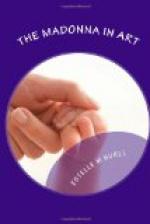[Footnote 1: Stirling-Maxwell, in “Annals of the Artists of Spain.”]
[Illustration: GABRIEL MAX.—MADONNA AND CHILD.]
As the portrait picture was the first style of Madonna known to art, so, also, it is the last. By a leap of nearly a thousand years, we have returned, in our own day, to the method of the tenth century. It is strange that what was once a matter of necessity should at last become an object of choice. In the beginning of Madonna art, the limited resources of technique precluded any attempts to make a more elaborate setting. Such difficulties no longer stand in the way, and where we now see a portrait Madonna, the artist has deliberately discarded all accessories in order better to idealize his theme.
Take, for instance, the portrait Madonnas by Gabriel Max. Here are no details to divert the attention from motherhood, pure and simple. We do not ask of the subject whether she is of high or of low estate, a queen or a peasant. We have only to look into the earnest, loving face to read that here is a mother. There are two pictures of this sort, evidently studied from the same Bohemian models. In one, the mother looks down at her babe; in the other, directly at the spectator, with a singularly visionary expression. When weary with the senseless repetition of the set compositions of past ages, we turn with relief to a simple portrait mother like this, at once the most primitive and the most advanced form of Madonna art. It is only another case where the simplest is the best.
CHAPTER II.
THE MADONNA ENTHRONED.
In every true home the mother is queen, enthroned in the hearts of her loving children. There is, therefore, a beautiful double significance, which we should always have in mind, in looking at the Madonna enthroned. According to the theological conception of the period in which it was first produced, the picture stands for the Virgin Mother as Queen of Heaven. Understood typically, it represents the exaltation of motherhood.
In the history of art development, the enthroned Madonna begins where the portrait Madonna ends. We may date it from the thirteenth century, when Cimabue, of Florence, and Guido, of Siena, produced their famous pictures. Similar types had previously appeared in the mosaic decorations of churches, but now, for the first time, they were worthily set forth in panel pictures.
The story of Cimabue’s Madonna is one of the oft-told tales we like to hear repeated. How on a certain day, about 1270, Charles of Anjou was passing through Florence; how he honored the studio of Cimabue by a visit; how the Madonna was then first uncovered; how the people shouted so joyously that the street was thereafter named the Borgo dei Allegri; and how the great picture was finally borne in triumphal procession to the church of Santa Maria Novella,—all these are the scenes in the pretty drama. The late Sir Frederick Leighton has preserved for future centuries this story, already six hundred years old, in a charming pageant picture: “Cimabue’s Madonna carried through the streets of Florence.” This was the first work ever exhibited by the English artist, and was an important step in the career which ended in the presidency of the Royal Academy.




